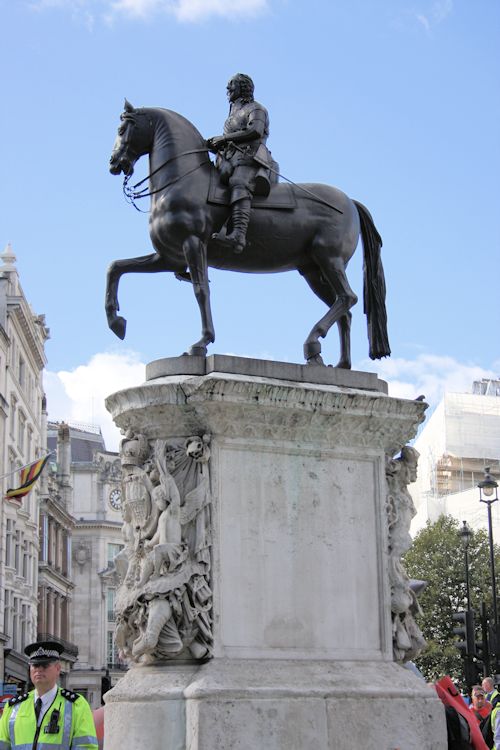The Statue of King Charles I of England

The statue shows Charles I of England on horseback, with the king wearing a demi-suit of armour but without a helmet. Across the chest is a scarf tied into a bow on the right shoulder. The king is holding a baton in his right hand and the reins of the horse in his left
This small traffic island at the south side of Trafalgar Square, where traffic converges in all directions and is the centre from where all measurements for the distance to London are taken. The statue of King Charles I on horseback has survived in this position since 1675, many years before Nelson and the Battle of Trafalgar from where the Square takes its name. But like so much in London this statue has a few hidden secrets to discover.
This was the first Renaissance-style equestrian statue in England, cast in 1633 (the date 1633 inscribed on the horse's left forefoot) by the French sculptor Hubert Le Sueur, it was commissioned by Charles's Lord High Treasurer Richard Weston for the garden of his country house in Roehampton. After the beheading of King Charles I following the English Civil War, the statue was sold to John Rivett or Rivet, a metalsmith in Covent Garden, with the orders for it to be broken-up for scrap. Rivett made a small fortune by selling bits of metal as souvenirs, supposedly parts of the statue, but secretly keeping the statue hidden until the Restoration – and when the Kings son, Charles II expressed his sadness at the loss of his father’s statue, Rivett owned-up to his deception revealing the complete and unscathed statue. A complaint about Rivett was made to the House of Lords, it was decreed "That the said John Rivett shall permit and suffer the Sheriff of London to serve a replevin upon the said Statue and Horse of Brass that are now in his Custody." It was purchased by the King in 1675 and erected in its current position in the centre of London the same year.
The pedestal itself is made of Portland stone with a carved coat of arms; the work was completed by Joshua Marshall, who was a mason to Charles II.
On 28 October 1844, during the visit of Queen Victoria to open the Royal Exchange, the sword and the badge of the Order of the Garter were stolen. During the Second World War, the statue was removed by the Ministry of Works for protection and was stored at Mentmore Park, Leighton Buzzard. Before being returned to its plinth in Whitehall, the Ministry carried out some repairs on the statue, including adding a replacement sword and the badge of the Order of the Garter. Additionally, a bronze tablet was added to the base of the plinth, explaining the addition of the replacement items.
In 1977, the plinth was cleaned for the first time in three centuries. The work was conducted by the Department of the Environment and the department of conservation at the Victoria and Albert Museum.
London Time

Follow Us
The contents of this website are the property of knowledgeoflondon.com and therefore must not be reproduced without permission. Every effort is made to ensure the details contained on this website are correct, however, we cannot accept responsibility for errors and omissions.
© Copyright 2004 -
Contact Us | Advertise